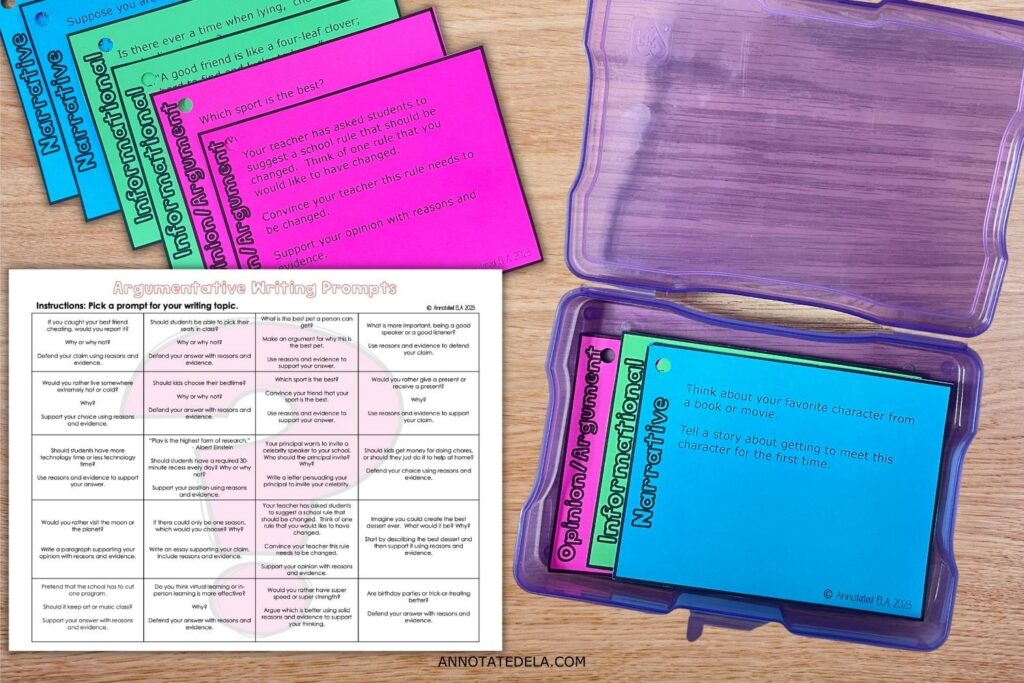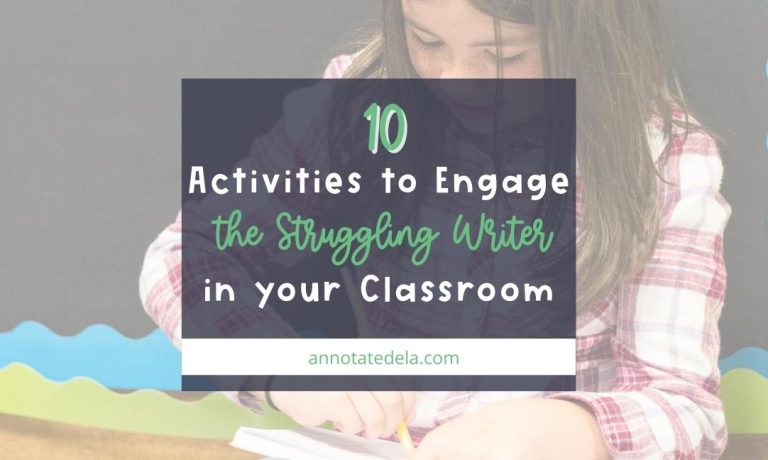Writing is hard work and not all students love writing, okay there are plenty of students who do not like writing – so what do we do with a struggling writer? As teachers, we want to find strategies for our struggling writers to engage them in writing, create writing independence, and increase stamina and volume of writing.
Determining engagement is simpler than you think with a simple chart, some writing time in class, and a keen teacher’s eye you can spot who is struggling and take action with these ten activities to engage the struggling writer.
A writer’s notebook is an essential tool for all writers and a great way for the teacher to get to know their students as writers. Join me for the 5 Day Notebook Challenge and get a jumpstart on writing in your classroom.
Writer’s Space
One strategy is to have students think about a space where they get the most work done or feel the most comfortable. The students should describe this space in their notebooks and they can even go as far as sketching the space.
Some students may not have a space in mind. When this happens there are several options:
- Brainstorm productive spaces as a class and make a list
- View spaces where published authors work – many published authors will share their writing space on their website.
- Share your space and what it looks like with your class
While students cannot recreate the space in class, they may be able to include some of the elements that help them be productive.
Help students get their creative juices flowing with some prompts:
- What do you think you need in a writing space?
- Do you like quiet or background noise?
- What helps you write?
- What does a productive space look like for you?
- Describe it or sketch it!
The struggling writer may find some joy in writing if they can have something that helps them get started; it also lets them know that you value them as people and writers.
Use Your Surroundings
This strategy assumes that the class room is a space filled with reference charts and posters that are helpful to writing.
When a student is stuck and they find their mind starting to wander they can look around the classroom and find ideas to get them back on track. Sometimes, as writers, especially a struggling writer will get stuck and give up. They don’t know what to add or what to continue doing, so having charts they can use is helpful.
This strategy has to be practiced and some students may need to be prompted. I like a quick sticky note on the desk where I have jotted a reminder to use their surroundings, tap on the desk to get them on track, or a quick chat.
Possible prompts:
- What’s causing you to get stuck?
- Is there something in the room that could help?
- What step of the writing process are you on? Is there a chart or notes in your notebook that might help you?
- I noticed you caught yourself zoning out or daydreaming, that’s a great first step! What can you do to help yourself get back to writing?
Not all students will catch themselves daydreaming; some may even prefer to daydream, but keep checking in and guiding them.
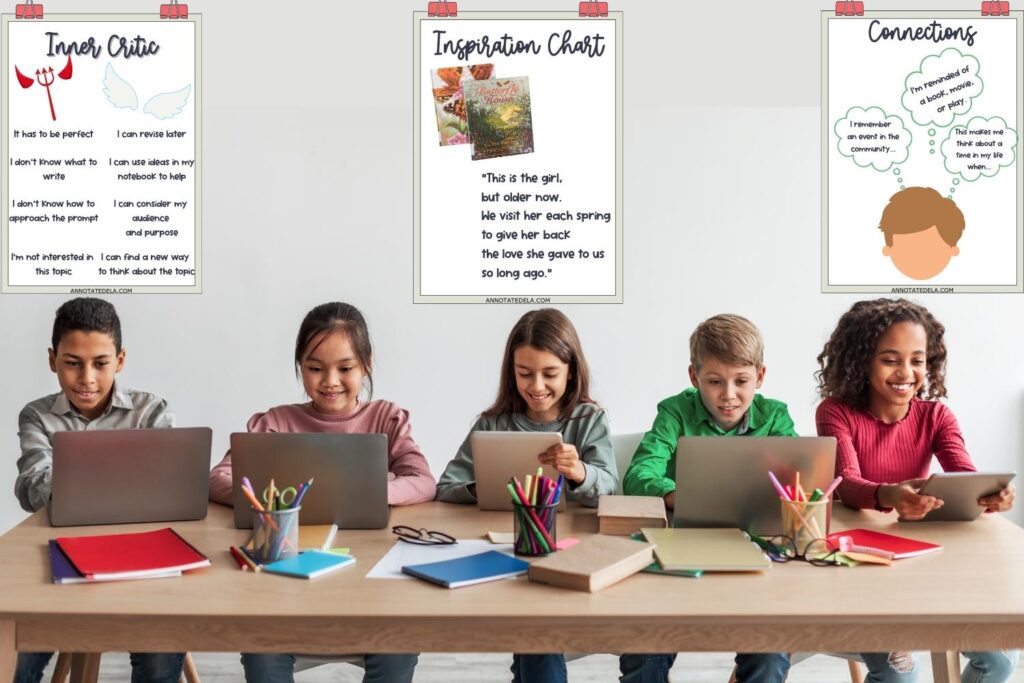
Solve Your Writer Problem
Writers solve problems, but first they have to identify the problem. A struggling writer may not be aware of why they are stuck.
Having a chart in the classroom or a note in their notebook of possible sticking points and how to solve the problem. Solving writing problems creates independence and builds confidence. When students are able to ‘fix’ the problem it opens up a new world of possibilities.
Possible prompts:
- What is stumping you?
- It seems like you’re stuck. Let’s brainstorm together some solutions.
- Is there something in the room or your notebook notes that might help you?
- Great idea! I agree! That chart or those notes will help.
Set a Writing Goal
When we don’t want to do something we often play a game with ourselves to ‘trick’ our minds into doing the hard thing.
For writers who do not enjoy writing or who struggle with writing, filling a whole page may feel impossible. Setting a goal by placing a dot or drawing a line to indicate how much will be written makes the task feel doable and eliminates undue stress.
During writing time encourage the struggling writer to write more, increasing the lines to build stamina and confidence. Over time they can go back and see their progress to celebrate how far they have come in their writing.
Possible prompts:
- Prompt the student about the time and to keep going – encourage them to stay on track.
- You put your dot or drew your line here, do you think you could slide it down a couple more lines?
- Push further and move your dot or line down a line.
- Congratulations! You met your goal; let’s set a new goal!
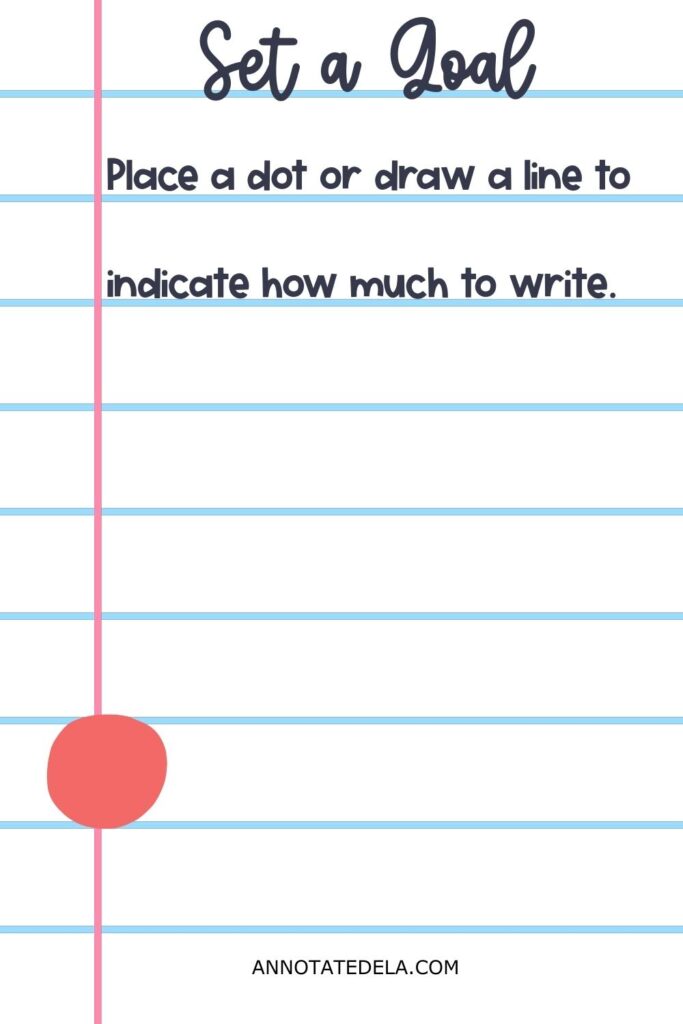
Break Up Writing Time
This strategy is similar to setting a goal, but instead of trying to get a certain amount of writing accomplished the struggling writer will write for a set amount of time and then take a timed break.
Have the student set a realistic time goal and write for the entire time. The break also needs to be timed so that the student does not lose interest. It can also be beneficial to keep a log of breaks and what was accomplished. Having the student track their writing allows them to track their progress and celebrate success.
Possible prompts:
- How long are you going to write?
- What amount of writing do you think you can accomplish in that time?
- How long will your break be?
- How many breaks will you take during our writing time?
Inspiration Chart
Having resources for students to reference is the best strategy and the inspiration chart is a perfect way to spark ideas.
The chart can be an anchor chart that hangs in the room or a chart that students keep in their notebooks. Most often inspiration charts are passages from picture books, nonfiction text, or novels we have read as a class and analyzed for the writer’s craft.
We keep a chart as a class, and students glue passages in their notebooks to keep as a reference. If a student is stuck, they can go and read passages that might spark an idea or encourage them to try a new strategy.

Possible prompts:
- Is there a text or passage that might help?
- Why are you stuck?
- Are you stuck on word choice? Structure? Voice?
- Is there an author that might help?
Connections to the Topic
When students make connections to their writing topics outside of the classroom it sparks new ideas and interest in the topic. Help your struggling writer make connections to their writing in the world around them.
Just like readers make connections, writers make connections too. The students can bring new connections to their writing when they feel stuck.
Possible prompts:
- What does this remind you of in your everyday life?
- What can you think about after writing time?
- How can you continue your thinking away from your desk?
- Does this remind you of a movie or a book?

Get it Off Your Chest
Sometimes our students have other, more important thoughts that are causing writer’s block. Offering these students a chance to spend a couple minutes writing about what is bothering them can free up space for the writing assignment.
This strategy also conveys to your students that you understand they have lives outside of the classroom; which builds a relationship and motivation.
Giving a set amount of time for ‘venting’ ensures that the student is focused and will get to the assignment before time is over on the writing time.
Possible prompts:
- Get it off your chest now, and you can write later.
- Now that you’ve had time to vent, spend some time writing on the topic.
- Is there something you need to get off your chest? Spend a few minutes writing about it.
- I can tell you feel better. Are you ready to write?
Banish the Inner Critic
We all have that voice in our head telling us that what we are writing is not good enough. For our struggling writer that voice can get loud, so finding a strategy to quiet that voice will help to build confidence.
Help your students be realistic about their writing expectations. It takes multiple drafts to publish a final draft. Find interviews about published authors who share how many drafts they had to revise before it was published to help students brainstorm ideas.
It is also helpful to model writing as a teacher. Often a struggling writer, or any of our writers, assumes it is one draft and done; but we know that writing is a process. Modeling this process shows students that even experienced writers need time to revise and edit.
Have a chart or other reference that reminds them to banish those negative thoughts. It can be helpful to make this chart as a class.
Possible prompts:
- Tell me about your writing goal and expectations today.
- Is your goal realistic? Are your expectations realistic?
- Let’s talk about what you could do today.
- Is there an obstacle to what you hope to accomplish?
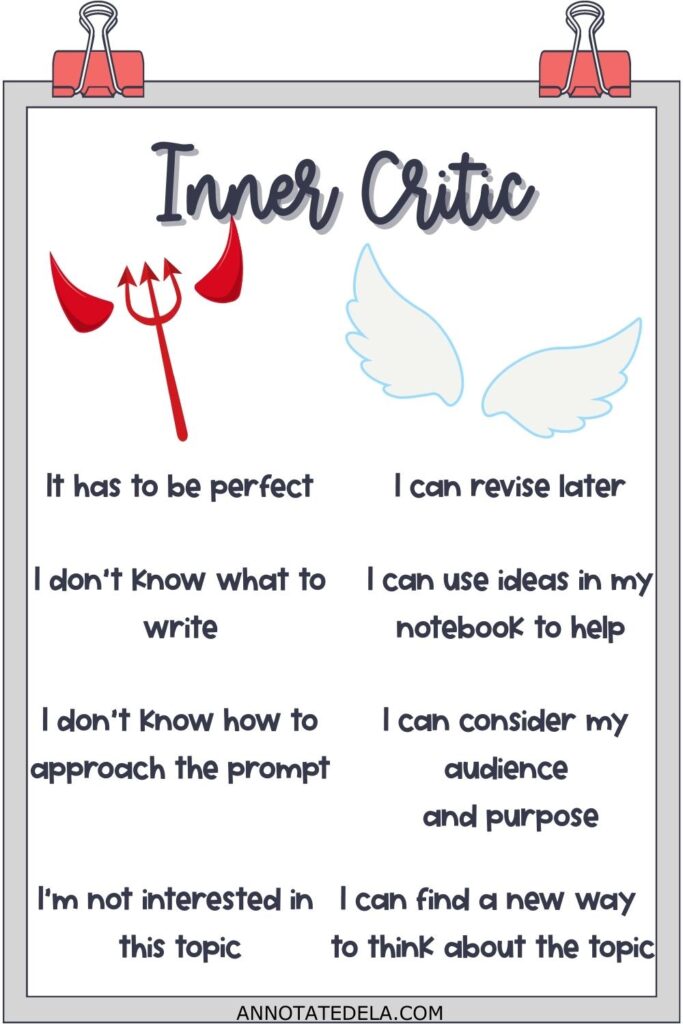
Use Writing Prompts
A struggling writer may need writing prompts to get started. Using creative prompts and creative ways mix prompts may be just enough to get students excited about writing and even coming up with their own ideas.
Having prompts available during writing time will make it easy for students to quietly get what they need and get down to writing. Providing a variety of prompts in different genres will give students choice and increase motivation because the student has some choice. Grab 60 writing prompts in the Writing Prompts Bundle to motivate the struggling writer in your class and engage your students in the writing process.
